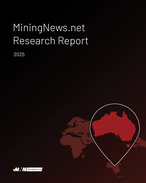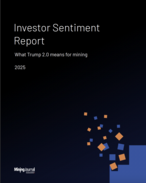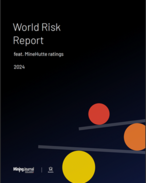This article is 11 years old. Images might not display.
Like many other Western Australian nickel sulphide miners, Mincor Resources has not let the 2.5-year price plunge beat it but has a few more aces up its sleeve that may provide yet more upside for the resilient trooper.
Mincor managing director David Moore spoke to RESOURCESTOCKS on October 22, the day the company issued third quarter figures showing a 14.4% drop in group cash costs from the corresponding period in 2012.
The Q3 figures also showed production from Kambalda over the three months to September came to 2883 tonnes of nickel in ore, up 17.9% from the previous corresponding period.
"You'd have to go back to mid-2011 to get better volumes out of the mines," Moore told RESOURCESTOCKS.
It coincided with the announcement that Mincor had sold its high-cost joint venture interests in the Bolobip and May River copper-gold tenements in Papua New Guinea to partner Niuminco in return for a 5% net smelter return royalty on 100% of future production from any future discoveries.
This gives Mincor exposure to the upside of any discovery that may be made, with no further funding risk for Mincor.
The PNG deal was part of a wider strategy to focus Mincor's exploration efforts around Kambalda, both for nickel and gold.
"We're in this incredibly lucky position where, after 2.5 years of dreadful falling nickel prices we're still committing serious dollars to really serious, credible exploration, offering really credible exploration upside to our shareholders, still keeping our mines running and still paying dividends to our shareholders," Moore said.
"There are not many mining companies, big or small, that could say that at the bottom of the cycle. Everyone's a hero at the top of the cycle.
"Investment fashions come and go. One commodity is the rage then there's another. Journalists love to use the term ‘the unloved nickel market'. Broadly speaking that is true - we're all down from where we were. But it's actually a bloody strong and resilient nickel sulphide mining industry in WA.
It's a point I've made before but it's worth repeating."
Luck, however, appears to have had very little to do with Mincor's success. The company made very substantial changes several times to cope with and accommodate the sharp drop in the nickel price these past few years.
This management success, along with some lateral thinking, also set the company up for what could be some nice surprises in the future.
While Mincor's two northern Kambalda mines - McMahon and Otter Juan - will likely be closed by Christmas on the basis of depletion of ore reserves, Miitel and Mariners are still very strong. Moore says they look like they may well have a very healthy life ahead of them.
Half of what Mincor mined during the past year it replaced during the year - and that was really only firing on one cylinder instead of two because that increase in reserves came from Miitel. The company wasn't able to drill Mariners because it didn't have the right drill positions.
This year it has those drill positions at Mariners, so Mincor can hope for an increase in reserves at both Miitel and Mariners.
"So I'm reasonably confident that we can continue to do this. Obviously we can't do it forever because eventually we're not going to replace our reserves but it is something we've been able to do quite successfully for a fairly long period of time," Moore said.
"Miitel and Mariners have about three years of formal reserves but in terms of what we expect I'd hope for another 5-7 years out of these mines. I can't put my hand on that material but I can point to where we hope it's going to come from and it just needs more drilling.
"The other thing that's not fully appreciated is that if we had a return to reasonably strong nickel prices - like the consensus forecast of $US10 a pound which, over the next five years or so starting from next year some time, averages out at about $A24,000/t - we will be opening mines."
The company has them ready to go, with 18,000-20,000t of nickel at Durkin - where Mincor will be taking off from an existing underground development - and another similar amount in Stockwell (20,800t) which will be a whole new mine.
Meanwhile, McMahon, which will be shutting before Christmas, has a lower-grade down below the end of the decline that Mincor could push down to mine out if the nickel price was better.
"So a better nickel price could not only increase production for Mincor but could increase mine life, bringing new metal into reserves. So the company is looking very solid," Moore said.
With the prolific 40-year history of Kambalda as a successful nickel sulphide province - Moore estimates that more than 50 individual orebodies have been discovered over that time - he is confident Mincor's model of opening and closing mines while replacing reserves can continue for the foreseeable future.
The orebodies that have been discovered around Kambalda, while physically small, have been high value, if quite hard to find. With that in mind, Moore believes that despite all the exploration that has been done, "you'd have to say there is more exploration potential"
That's why the company is reducing its interest elsewhere and focusing more on Kambalda - and Mincor has the cash to do it.
Right now, Mincor has two "quite interesting" nickel sulphide prospects that it is busy working on, with some ideas in North Kambalda coming into play, which could start a whole new chapter in the Kambalda nickel sulphide story.
Mincor recently announced it was planning an electromagnetic survey over the centre of the Kambalda basalt dome.
"EM is a very successful surface geophysical tool used to find massive sulphides to a certain depth," Moore explained.
"All the nickel sulphide orebodies are draped around the edge of the dome but the basalt is quite complex and it's quite possible that you've got high-grade massive sulphides folded into the basalt.
"You'd think that would've been explored for by now but to our astonishment we found there has never been any EM done over the centre of the Kambalda dome.
"One of the reasons is that it's full of infrastructure - pipelines, overhead power lines, fence lines - which make it quite difficult."
But Moore believes it is still doable and is planning a program that will utilise windows in-between the infrastructure - and in some cases will knock down fences then put them back up again and switch off power lines briefly to get to those as yet untested plays.
"It's something completely new, never been done and could well discover near-surface high-grade massive sulphides in basalt, which anyone will tell you is a great place to find it because it's nice hard rock for a hanging wall," Moore said.
"We're pursuing these sorts of ideas all the time and this one we think, as a conceptual exploration play for high-grade nickel sulphide, is a very good one because the Kambalda dome is still the heart of where the bulk of Kambalda's nickel has come from."
The company is also exploring some "really exciting" gold prospects, with Kambalda just as much a gold field as it is a nickel field, according to Moore - and there are plenty of gold mines all around Mincor's ground.
"Anything we find on the gold side, as with nickel, will be something we can put into production fairly easily and quickly using our existing manpower, equipment and management structure," Moore said.
"We could find anything from a smallish discovery, for which we could get a tolling arrangement from one of the three to four nearby gold mills, or if we found a big one, we could build our own plant.
"We have plenty of money to fund that exploration and we're going at it full tilt."
Across the other side of Australia, Mincor completed some work this year on its Tottenham copper project in New South Wales and has strategically dropped some ground, holding onto core tenements to reduce exploration expenditure in that part of the world.
Mincor also has the Bonaparte lead-zinc prospect to the north of Kununurra in WA, which is still active, with joint venture partner Japanese government-owned JOGMEC funding exploration there.
North Limited's work in the early 1990s uncovered a number of soil geochemical and geophysical anomalies in the area, which is a region of known zinc-lead prospectivity.
However, while all that can continue, Mincor's exploration focus is Kambalda - and for good reason.
"It can be invidious to make comparisons but if you look at the slaughter that's taken place in the gold mining sector on the back of the 10-15% drop in the gold price, it highlights how resilient the nickel sector is, because we've had a 50-70% drop, just in the past 2.5 years and most of the nickel miners are still standing," Moore said.
"The Western Australian underground nickel sulphide miners show a very robust business - and you want to invest in companies that can survive the downturns and do well during the upturns."
*A version of this report, first published in the December 2013 edition of RESOURCESTOCKS magazine, was commissioned by Mincor Resources























